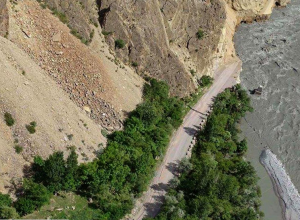Humans must start removing carbon dioxide from the atmosphere as soon as possible to avoid saddling future generations with a choice between extreme climate change or spending hundreds of trillions of dollars to avoid it, according to new research.
An international team of researchers – led by Professor Jim Hansen, Nasa’s former climate science chief – said their conclusion that the world had already overshot targets to limit global warming to within acceptable levels was “sufficiently grim” to force them to urge “rapid emission reductions”.
But they warned this would not be enough and efforts would need to be made to reduce the amount of carbon dioxide in the atmosphere by about 12.5 per cent.
This, the scientists argued, could be mostly achieved by agricultural measures such as planting trees and improving soil fertility, a relatively low-cost way to remove carbon from the air.
Other more expensive methods, such as burning biomass in power plants fitted with carbon-capture-and-storage or devices that can remove carbon from the air directly, might also be necessary and would become increasingly needed if steps were not taken soon.
An academic paper in the journal Earth System Dynamics estimated such industrial processes could cost up to $535 trillion this century and “also have large risks and uncertain feasibility”.
“Continued high fossil fuel emissions unarguably sentences young people to either a massive, implausible clean-up or growing deleterious climate impacts or both,” said the paper.
“We conclude that the world has already overshot appropriate targets for greenhouse gas amount and global temperature, and we thus infer an urgent need for rapid phasedown of fossil fuel emissions [and] actions that draw down atmospheric carbon dioxide.
“These tasks are formidable and … they are not being pursued globally.”
Cuts to emissions of greenhouse gases such as methane, nitrous oxide and ozone would also be required.
The study is to be used as part of a ground-breaking lawsuit brought against the US Government by 21 children in which the plaintiffs claim their constitutional right to have a health climate in which to live in is being violated by federal policies.
If the case succeeds, environmentalists believe it could force the Trump administration to reduce greenhouse gases and take other measures to prevent global warming.
The paper pointed out that the last time temperatures were this high, during the Eemian period, global sea levels were about six to nine metres higher than they are today, suggesting significant rises are still to occur.
The paper said that the Paris Agreement, the tumbling price of renewable energy and the recent slowdown in the increase of fossil fuel emissions had led to a sense of optimism around the world.
But, speaking to The Independent, Professor Hansen said he believed this optimism was misplaced.
“The narrative that’s out there now … is that we’ve turned the corner,” he said.
“On the contrary, what we show is the rate of growth of climate forcing caused by increased methane [and other gases] is actually accelerating. That’s why it’s urgent.”
Asked to assess the world’s current progress in fighting climate change, he said the “s*** is hitting the fan”.
Professor Hansen, now a scientist at the Columbia University Earth Institute in the US, said he believed the court case had a chance of winning.
A court would not be able to tell the Government what to do, he admitted, but would be able to say that failing to deal with the problem was unconstitutional and require politicians to produce an effective plan.
The paper said the need for “prompt action implied by these realities [of climate change] may not be a surprise to the relevant scientific community” because of the available evidence.
“However, effective communication with the public of the urgency to stem human-caused climate change is hampered by the inertia of the climate system, especially the ocean and the ice sheets, which respond rather slowly to climate forcings, thus allowing future consequences to build up before broad public concern awakens,” it said.
“All amplifying feedbacks, including atmospheric water vapor, sea ice cover, soil carbon release and ice sheet melt could be reduced by rapid emissions phasedown.
“This would reduce the risk of climate change running out of humanity’s control and provide time to assess the climate response, develop relevant technologies, and consider further purposeful actions to limit and/or adapt to climate change.”
It warned that sea level rise of up to a metre “may be inevitable even if emissions decline” and would have “dire consequences”.
Sea level rise of several metres would result in “humanitarian and economic disasters”.
“Given the increasing proportion of global population living in coastal areas, there is potential for forced migrations of hundreds of millions of people, dwarfing prior refugee humanitarian crises, challenging global governance and security,” the paper said.
About 65 per cent of the power produced by the massive Drax power plant in North Yorkshire comes from burning biomass, making it the largest single renewable electricity generator in the UK, although some dispute how green the process is.
If it was to be fitted with carbon-capture-and-storage (CCS), it would create the type of negative emissions system envisaged in the paper. Drax was involved in the White Rose project to build a £1bn CCS plant but pulled out after cuts to renewable energy subsidies by the Government.
It insisted that biomass with CCS could make a major difference to the fight against climate change.
A Drax spokesperson said: “We are confident the technology we developed as part of the White Rose project has real potential in terms of delivering dramatic reductions to carbon emissions produced by power stations and heavy industry.
“However, the current regulatory environment means any such project isn’t viable at the present time. We are also awaiting the Government’s response to Lord Oxburgh’s review into CCS.”
Source: www.independent.co.uk
Ask me anything
Explore related questions










